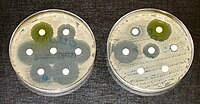
Photo from wikipedia
Abstract Funding Acknowledgements Type of funding sources: None. Background Coronavirus disease 2019 (COVID-19) is caused by the novel severe acute respiratory syndrome coronavirus 2. Pulmonary vascular resistance (PVR) is an… Click to show full abstract
Abstract Funding Acknowledgements Type of funding sources: None. Background Coronavirus disease 2019 (COVID-19) is caused by the novel severe acute respiratory syndrome coronavirus 2. Pulmonary vascular resistance (PVR) is an important hemodynamic variable used in the management of patients with cardiovascular and pulmonary pathology. Doppler echocardiography has significantly impacted clinical medicine by its ability to assess intracardiac hemodynamics noninvasively. It seems actual to reveal the relationship between right heart function and lungs involvement in COVID-19. Purpose To assess the relationship right ventricular (RV) echocardiographic structural and functional parameters with indicators of increased pulmonary vascular resistance (PVR) in patients 3 months after COVID-19 pneumonia. Methods 96 patients (mean age 47.6 ± 15.2 years) were examined during hospitalization and at control visit (3 months follow-up). The equation tricuspid regurgitation velocity / time-velocity integral of the RV outflow tract X 10 + 0.16 has been used to determine PVR. Patients were divided into 2 groups: I group (n = 31) – patients with increase of PVR ≥1.5 Wood unit (WU) and II group (n = 65) – with decrease of PVR <1.5 WU. Results At baseline groups did not differ in main clinical characteristics, including severity of lung involvement in COVID-19 by computed tomography (32.7 ± 22.1% vs 36.5 ± 20.4%, р=0.418). Linear, planimetric and volumetric parameters did not differ significantly between groups. At the control visit RV free wall (FW) global endocardial longitudinal strain (LS) (-19.3 [-17.9; -25.8] % in group I vs -23.4 [-19.8; -27.8] % in group II, p = 0.048), tricuspid annular plane systolic excursion (21.7 ± 3.8 mm vs 23.3 ± 3.4 mm, p = 0.040) and RV maximum systolic velocity assessed by tissue Doppler imaging (12.3 ± 2.4 cm/s vs 13.4 ± 2.0 cm/s, p = 0.024) were significantly reduced in group I, systolic pulmonary artery pressure (sPAP) according to Otto C. (32.0 [26,0; 35.0] mm Hg vs 23.0 [20.0; 28.0] mm Hg, p <0.001) was significantly increased in group I. According to logistic regression only endocardial RV FW LS (OR 0.859; 95% CI 0.746 - 0.989; p = 0.034) and sPAP (OR 1.248; 95% CI 1.108 - 1405; p <0.001) had an independent relationship with increase of PVR. According to Spearman correlation analysis the moderate relationship was found between PVR and mean pulmonary artery pressure according to Mahan G. (r = 0.516, p = 0.003), PVR and RV–pulmonary artery coupling (r=-0.509, p = 0.007) in group I at the control visit. Conclusion Hidden RV systolic dysfunction defined as decreased endocardial RV FW LS to -19.3% is associated with increased PVR ≥1.5 WU in patients 3 months after COVID-19 pneumonia. Abstract Figure. RV FW LS by STE
Journal Title: European Heart Journal Cardiovascular Imaging
Year Published: 2022
Link to full text (if available)
Share on Social Media: Sign Up to like & get
recommendations!